Impact of Digital Resources on Adult Student Wellbeing: UKCBC Research
VerifiedAdded on 2022/12/29
|44
|14931
|146
Project
AI Summary
This dissertation investigates the influence of digital resources, such as e-books and e-journals, on the digital wellbeing of adult students at UKCBC Wentworth House Campus. The research employs a qualitative approach, utilizing semi-structured interviews with ten students to gather primary data on their perceptions and experiences. The methodology includes an epistemological research philosophy and an interpretivist paradigm, with an inductive approach for building theory. The findings, analyzed through thematic analysis, reveal that students generally find e-resources more accessible than print materials, particularly for those with part-time jobs. The study highlights both the positive impacts on wellbeing and potential health concerns associated with prolonged digital resource use. The discussion section analyzes the impact, compares digital and print resources, and offers recommendations for the institution to enhance digital resource usage. The conclusion summarizes key findings and suggests avenues for future research, such as expanding the sample size. The reflection section provides a personal account of the research process. The report includes a comprehensive executive summary, methodology chapter, results/findings chapter, discussion chapter, conclusion, recommendations, and reflection, providing a thorough analysis of the research topic and its implications.

Running head: DISSERTATION
An exploration of the impact of using digital resources such as e-books and e-
journals on the adult students (UKCBC Wentworth House Campus) wellbeing for
their studies?
Name of Student
Name of University
Author Note
An exploration of the impact of using digital resources such as e-books and e-
journals on the adult students (UKCBC Wentworth House Campus) wellbeing for
their studies?
Name of Student
Name of University
Author Note
Paraphrase This Document
Need a fresh take? Get an instant paraphrase of this document with our AI Paraphraser
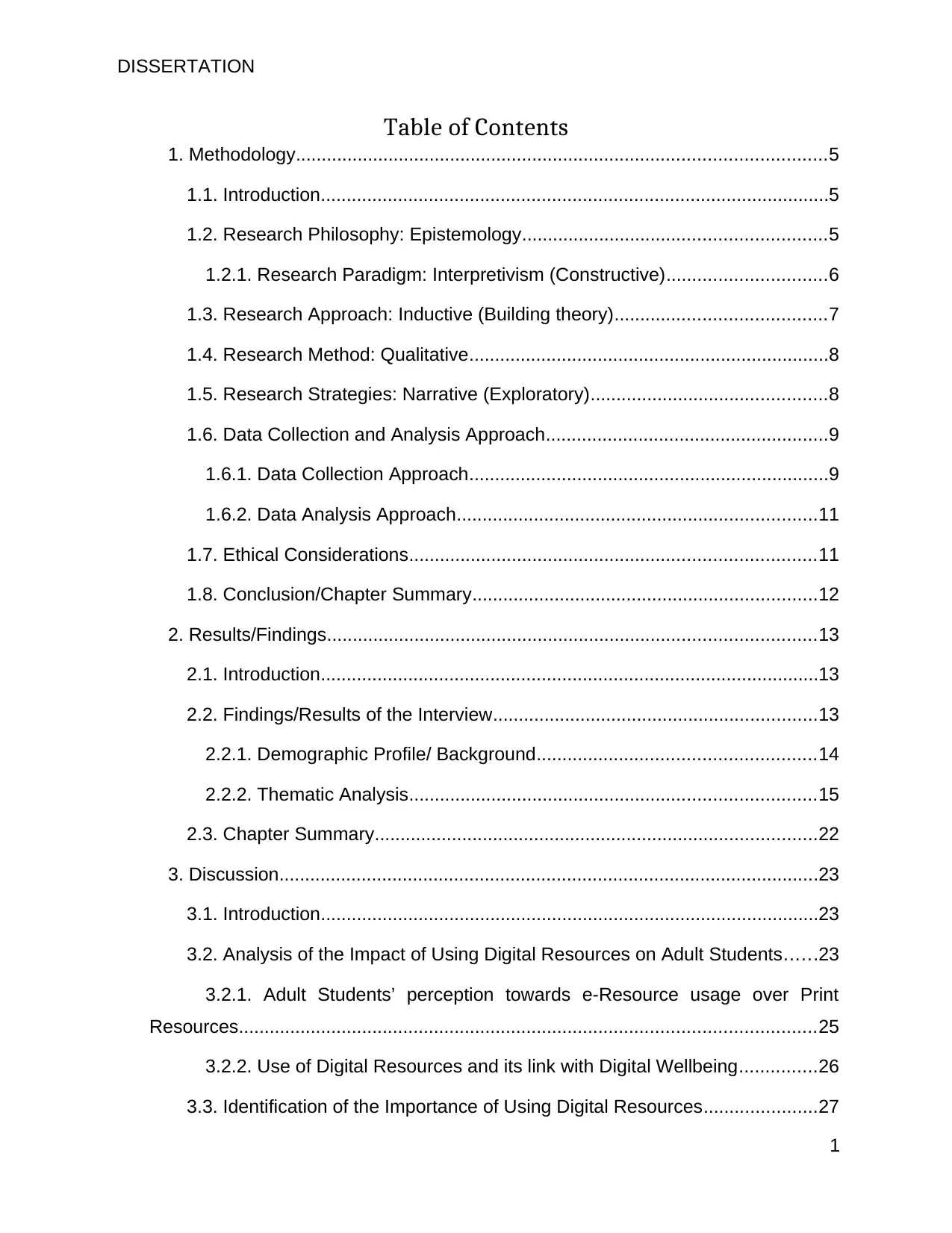
DISSERTATION
Table of Contents
1. Methodology.......................................................................................................5
1.1. Introduction...................................................................................................5
1.2. Research Philosophy: Epistemology...........................................................5
1.2.1. Research Paradigm: Interpretivism (Constructive)...............................6
1.3. Research Approach: Inductive (Building theory).........................................7
1.4. Research Method: Qualitative......................................................................8
1.5. Research Strategies: Narrative (Exploratory)..............................................8
1.6. Data Collection and Analysis Approach.......................................................9
1.6.1. Data Collection Approach......................................................................9
1.6.2. Data Analysis Approach......................................................................11
1.7. Ethical Considerations...............................................................................11
1.8. Conclusion/Chapter Summary...................................................................12
2. Results/Findings...............................................................................................13
2.1. Introduction.................................................................................................13
2.2. Findings/Results of the Interview...............................................................13
2.2.1. Demographic Profile/ Background......................................................14
2.2.2. Thematic Analysis...............................................................................15
2.3. Chapter Summary......................................................................................22
3. Discussion.........................................................................................................23
3.1. Introduction.................................................................................................23
3.2. Analysis of the Impact of Using Digital Resources on Adult Students......23
3.2.1. Adult Students’ perception towards e-Resource usage over Print
Resources................................................................................................................25
3.2.2. Use of Digital Resources and its link with Digital Wellbeing...............26
3.3. Identification of the Importance of Using Digital Resources......................27
1
Table of Contents
1. Methodology.......................................................................................................5
1.1. Introduction...................................................................................................5
1.2. Research Philosophy: Epistemology...........................................................5
1.2.1. Research Paradigm: Interpretivism (Constructive)...............................6
1.3. Research Approach: Inductive (Building theory).........................................7
1.4. Research Method: Qualitative......................................................................8
1.5. Research Strategies: Narrative (Exploratory)..............................................8
1.6. Data Collection and Analysis Approach.......................................................9
1.6.1. Data Collection Approach......................................................................9
1.6.2. Data Analysis Approach......................................................................11
1.7. Ethical Considerations...............................................................................11
1.8. Conclusion/Chapter Summary...................................................................12
2. Results/Findings...............................................................................................13
2.1. Introduction.................................................................................................13
2.2. Findings/Results of the Interview...............................................................13
2.2.1. Demographic Profile/ Background......................................................14
2.2.2. Thematic Analysis...............................................................................15
2.3. Chapter Summary......................................................................................22
3. Discussion.........................................................................................................23
3.1. Introduction.................................................................................................23
3.2. Analysis of the Impact of Using Digital Resources on Adult Students......23
3.2.1. Adult Students’ perception towards e-Resource usage over Print
Resources................................................................................................................25
3.2.2. Use of Digital Resources and its link with Digital Wellbeing...............26
3.3. Identification of the Importance of Using Digital Resources......................27
1
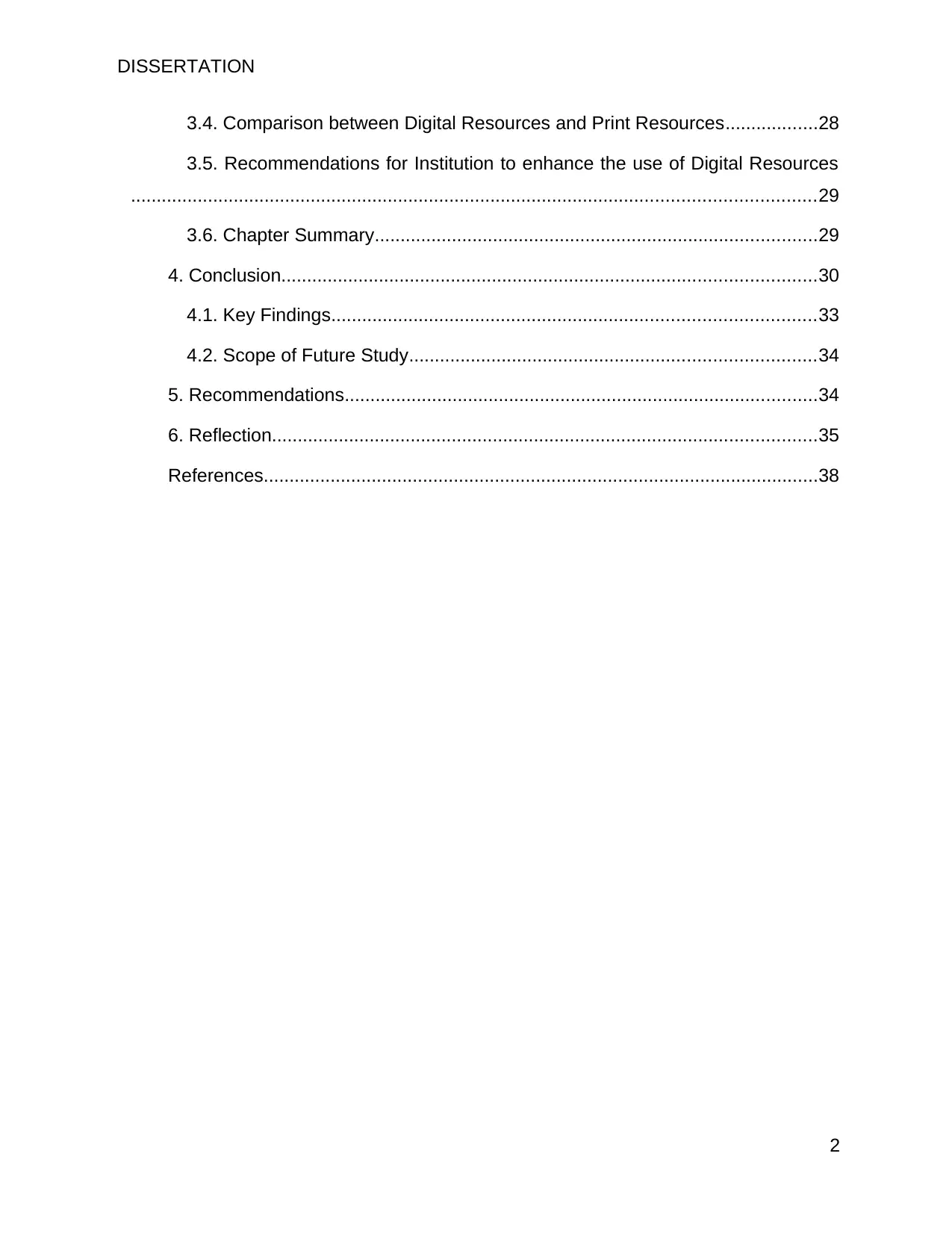
DISSERTATION
3.4. Comparison between Digital Resources and Print Resources..................28
3.5. Recommendations for Institution to enhance the use of Digital Resources
.....................................................................................................................................29
3.6. Chapter Summary......................................................................................29
4. Conclusion........................................................................................................30
4.1. Key Findings..............................................................................................33
4.2. Scope of Future Study...............................................................................34
5. Recommendations............................................................................................34
6. Reflection..........................................................................................................35
References............................................................................................................38
2
3.4. Comparison between Digital Resources and Print Resources..................28
3.5. Recommendations for Institution to enhance the use of Digital Resources
.....................................................................................................................................29
3.6. Chapter Summary......................................................................................29
4. Conclusion........................................................................................................30
4.1. Key Findings..............................................................................................33
4.2. Scope of Future Study...............................................................................34
5. Recommendations............................................................................................34
6. Reflection..........................................................................................................35
References............................................................................................................38
2
⊘ This is a preview!⊘
Do you want full access?
Subscribe today to unlock all pages.

Trusted by 1+ million students worldwide
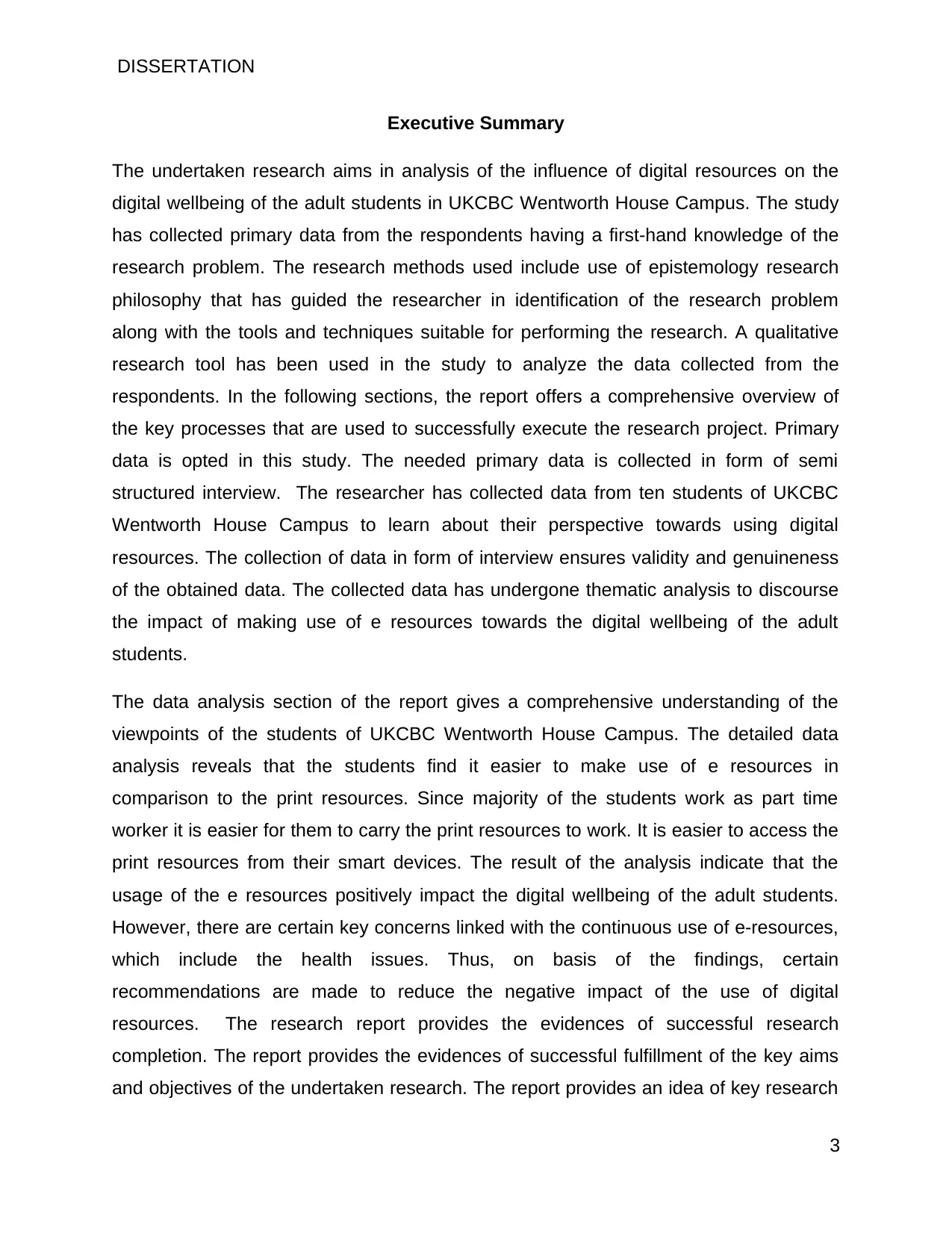
DISSERTATION
Executive Summary
The undertaken research aims in analysis of the influence of digital resources on the
digital wellbeing of the adult students in UKCBC Wentworth House Campus. The study
has collected primary data from the respondents having a first-hand knowledge of the
research problem. The research methods used include use of epistemology research
philosophy that has guided the researcher in identification of the research problem
along with the tools and techniques suitable for performing the research. A qualitative
research tool has been used in the study to analyze the data collected from the
respondents. In the following sections, the report offers a comprehensive overview of
the key processes that are used to successfully execute the research project. Primary
data is opted in this study. The needed primary data is collected in form of semi
structured interview. The researcher has collected data from ten students of UKCBC
Wentworth House Campus to learn about their perspective towards using digital
resources. The collection of data in form of interview ensures validity and genuineness
of the obtained data. The collected data has undergone thematic analysis to discourse
the impact of making use of e resources towards the digital wellbeing of the adult
students.
The data analysis section of the report gives a comprehensive understanding of the
viewpoints of the students of UKCBC Wentworth House Campus. The detailed data
analysis reveals that the students find it easier to make use of e resources in
comparison to the print resources. Since majority of the students work as part time
worker it is easier for them to carry the print resources to work. It is easier to access the
print resources from their smart devices. The result of the analysis indicate that the
usage of the e resources positively impact the digital wellbeing of the adult students.
However, there are certain key concerns linked with the continuous use of e-resources,
which include the health issues. Thus, on basis of the findings, certain
recommendations are made to reduce the negative impact of the use of digital
resources. The research report provides the evidences of successful research
completion. The report provides the evidences of successful fulfillment of the key aims
and objectives of the undertaken research. The report provides an idea of key research
3
Executive Summary
The undertaken research aims in analysis of the influence of digital resources on the
digital wellbeing of the adult students in UKCBC Wentworth House Campus. The study
has collected primary data from the respondents having a first-hand knowledge of the
research problem. The research methods used include use of epistemology research
philosophy that has guided the researcher in identification of the research problem
along with the tools and techniques suitable for performing the research. A qualitative
research tool has been used in the study to analyze the data collected from the
respondents. In the following sections, the report offers a comprehensive overview of
the key processes that are used to successfully execute the research project. Primary
data is opted in this study. The needed primary data is collected in form of semi
structured interview. The researcher has collected data from ten students of UKCBC
Wentworth House Campus to learn about their perspective towards using digital
resources. The collection of data in form of interview ensures validity and genuineness
of the obtained data. The collected data has undergone thematic analysis to discourse
the impact of making use of e resources towards the digital wellbeing of the adult
students.
The data analysis section of the report gives a comprehensive understanding of the
viewpoints of the students of UKCBC Wentworth House Campus. The detailed data
analysis reveals that the students find it easier to make use of e resources in
comparison to the print resources. Since majority of the students work as part time
worker it is easier for them to carry the print resources to work. It is easier to access the
print resources from their smart devices. The result of the analysis indicate that the
usage of the e resources positively impact the digital wellbeing of the adult students.
However, there are certain key concerns linked with the continuous use of e-resources,
which include the health issues. Thus, on basis of the findings, certain
recommendations are made to reduce the negative impact of the use of digital
resources. The research report provides the evidences of successful research
completion. The report provides the evidences of successful fulfillment of the key aims
and objectives of the undertaken research. The report provides an idea of key research
3
Paraphrase This Document
Need a fresh take? Get an instant paraphrase of this document with our AI Paraphraser

DISSERTATION
limitations that suggest a scope of future study in this research area. The report delivers
a detailed overview of the key area in which the undertaken research can further be
improved. The main limitation of this particular research is the constricted sample size
that is chosen for the study. The research involves collection of data from ten students
of UKCBC Wentworth House Campus, which is the main research limitation as more
accurate data could have been collected if the sample size was larger. The research
result suggest that since usage of digital resources has a positive effect on the digital
wellbeing of the adult students, the use of digital resources can be promoted in UKCBC
Wentworth House Campus.
4
limitations that suggest a scope of future study in this research area. The report delivers
a detailed overview of the key area in which the undertaken research can further be
improved. The main limitation of this particular research is the constricted sample size
that is chosen for the study. The research involves collection of data from ten students
of UKCBC Wentworth House Campus, which is the main research limitation as more
accurate data could have been collected if the sample size was larger. The research
result suggest that since usage of digital resources has a positive effect on the digital
wellbeing of the adult students, the use of digital resources can be promoted in UKCBC
Wentworth House Campus.
4
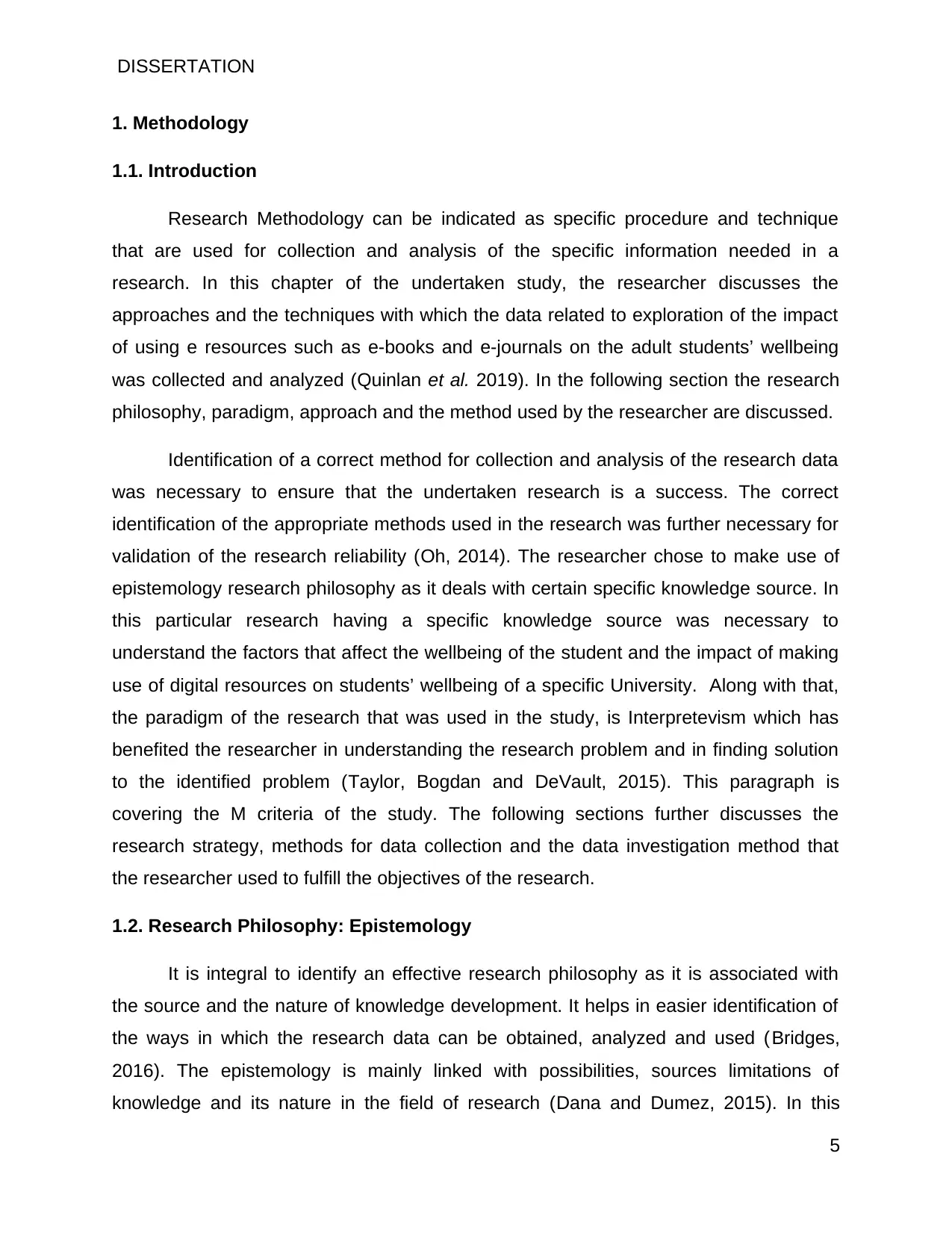
DISSERTATION
1. Methodology
1.1. Introduction
Research Methodology can be indicated as specific procedure and technique
that are used for collection and analysis of the specific information needed in a
research. In this chapter of the undertaken study, the researcher discusses the
approaches and the techniques with which the data related to exploration of the impact
of using e resources such as e-books and e-journals on the adult students’ wellbeing
was collected and analyzed (Quinlan et al. 2019). In the following section the research
philosophy, paradigm, approach and the method used by the researcher are discussed.
Identification of a correct method for collection and analysis of the research data
was necessary to ensure that the undertaken research is a success. The correct
identification of the appropriate methods used in the research was further necessary for
validation of the research reliability (Oh, 2014). The researcher chose to make use of
epistemology research philosophy as it deals with certain specific knowledge source. In
this particular research having a specific knowledge source was necessary to
understand the factors that affect the wellbeing of the student and the impact of making
use of digital resources on students’ wellbeing of a specific University. Along with that,
the paradigm of the research that was used in the study, is Interpretevism which has
benefited the researcher in understanding the research problem and in finding solution
to the identified problem (Taylor, Bogdan and DeVault, 2015). This paragraph is
covering the M criteria of the study. The following sections further discusses the
research strategy, methods for data collection and the data investigation method that
the researcher used to fulfill the objectives of the research.
1.2. Research Philosophy: Epistemology
It is integral to identify an effective research philosophy as it is associated with
the source and the nature of knowledge development. It helps in easier identification of
the ways in which the research data can be obtained, analyzed and used (Bridges,
2016). The epistemology is mainly linked with possibilities, sources limitations of
knowledge and its nature in the field of research (Dana and Dumez, 2015). In this
5
1. Methodology
1.1. Introduction
Research Methodology can be indicated as specific procedure and technique
that are used for collection and analysis of the specific information needed in a
research. In this chapter of the undertaken study, the researcher discusses the
approaches and the techniques with which the data related to exploration of the impact
of using e resources such as e-books and e-journals on the adult students’ wellbeing
was collected and analyzed (Quinlan et al. 2019). In the following section the research
philosophy, paradigm, approach and the method used by the researcher are discussed.
Identification of a correct method for collection and analysis of the research data
was necessary to ensure that the undertaken research is a success. The correct
identification of the appropriate methods used in the research was further necessary for
validation of the research reliability (Oh, 2014). The researcher chose to make use of
epistemology research philosophy as it deals with certain specific knowledge source. In
this particular research having a specific knowledge source was necessary to
understand the factors that affect the wellbeing of the student and the impact of making
use of digital resources on students’ wellbeing of a specific University. Along with that,
the paradigm of the research that was used in the study, is Interpretevism which has
benefited the researcher in understanding the research problem and in finding solution
to the identified problem (Taylor, Bogdan and DeVault, 2015). This paragraph is
covering the M criteria of the study. The following sections further discusses the
research strategy, methods for data collection and the data investigation method that
the researcher used to fulfill the objectives of the research.
1.2. Research Philosophy: Epistemology
It is integral to identify an effective research philosophy as it is associated with
the source and the nature of knowledge development. It helps in easier identification of
the ways in which the research data can be obtained, analyzed and used (Bridges,
2016). The epistemology is mainly linked with possibilities, sources limitations of
knowledge and its nature in the field of research (Dana and Dumez, 2015). In this
5
⊘ This is a preview!⊘
Do you want full access?
Subscribe today to unlock all pages.

Trusted by 1+ million students worldwide
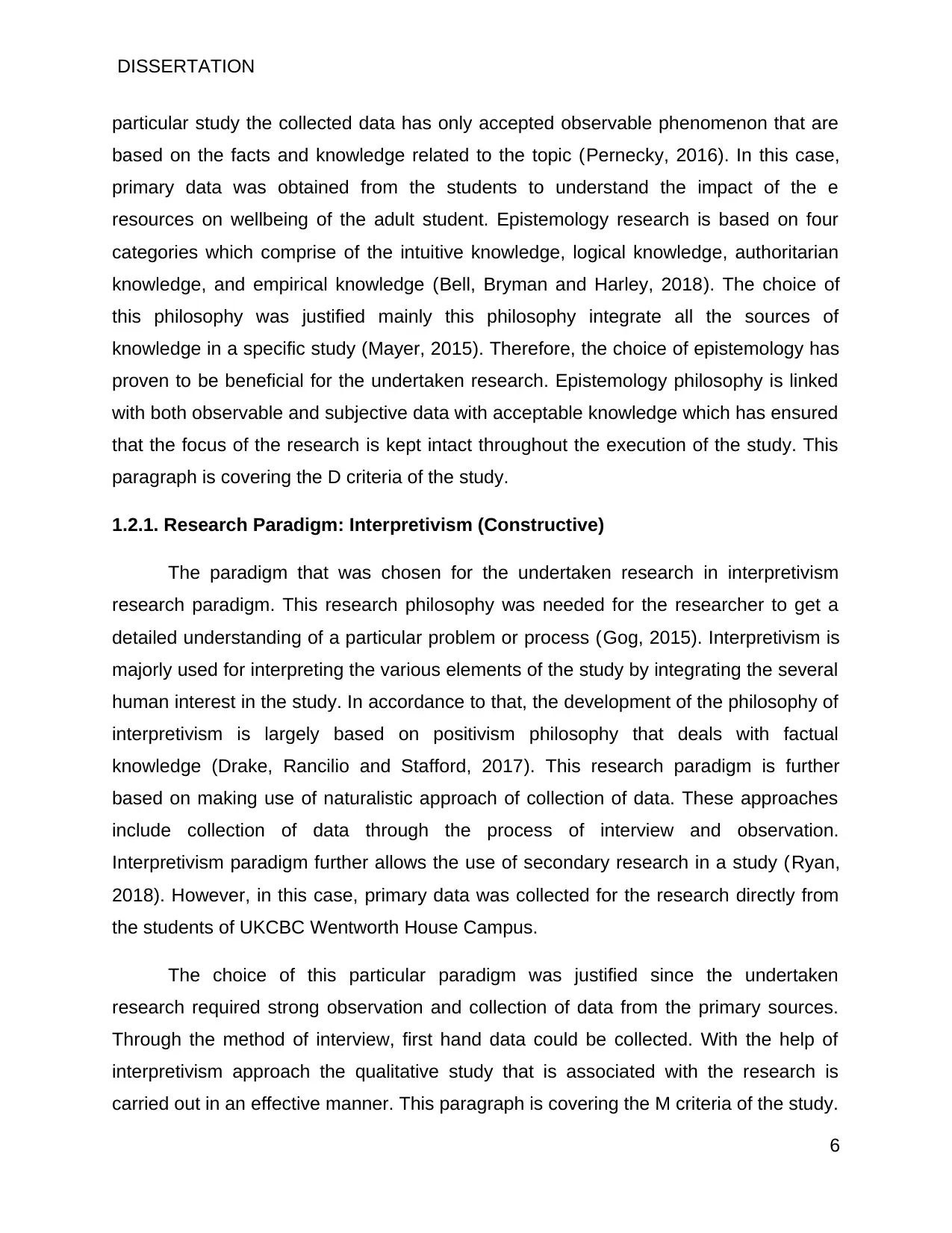
DISSERTATION
particular study the collected data has only accepted observable phenomenon that are
based on the facts and knowledge related to the topic (Pernecky, 2016). In this case,
primary data was obtained from the students to understand the impact of the e
resources on wellbeing of the adult student. Epistemology research is based on four
categories which comprise of the intuitive knowledge, logical knowledge, authoritarian
knowledge, and empirical knowledge (Bell, Bryman and Harley, 2018). The choice of
this philosophy was justified mainly this philosophy integrate all the sources of
knowledge in a specific study (Mayer, 2015). Therefore, the choice of epistemology has
proven to be beneficial for the undertaken research. Epistemology philosophy is linked
with both observable and subjective data with acceptable knowledge which has ensured
that the focus of the research is kept intact throughout the execution of the study. This
paragraph is covering the D criteria of the study.
1.2.1. Research Paradigm: Interpretivism (Constructive)
The paradigm that was chosen for the undertaken research in interpretivism
research paradigm. This research philosophy was needed for the researcher to get a
detailed understanding of a particular problem or process (Gog, 2015). Interpretivism is
majorly used for interpreting the various elements of the study by integrating the several
human interest in the study. In accordance to that, the development of the philosophy of
interpretivism is largely based on positivism philosophy that deals with factual
knowledge (Drake, Rancilio and Stafford, 2017). This research paradigm is further
based on making use of naturalistic approach of collection of data. These approaches
include collection of data through the process of interview and observation.
Interpretivism paradigm further allows the use of secondary research in a study (Ryan,
2018). However, in this case, primary data was collected for the research directly from
the students of UKCBC Wentworth House Campus.
The choice of this particular paradigm was justified since the undertaken
research required strong observation and collection of data from the primary sources.
Through the method of interview, first hand data could be collected. With the help of
interpretivism approach the qualitative study that is associated with the research is
carried out in an effective manner. This paragraph is covering the M criteria of the study.
6
particular study the collected data has only accepted observable phenomenon that are
based on the facts and knowledge related to the topic (Pernecky, 2016). In this case,
primary data was obtained from the students to understand the impact of the e
resources on wellbeing of the adult student. Epistemology research is based on four
categories which comprise of the intuitive knowledge, logical knowledge, authoritarian
knowledge, and empirical knowledge (Bell, Bryman and Harley, 2018). The choice of
this philosophy was justified mainly this philosophy integrate all the sources of
knowledge in a specific study (Mayer, 2015). Therefore, the choice of epistemology has
proven to be beneficial for the undertaken research. Epistemology philosophy is linked
with both observable and subjective data with acceptable knowledge which has ensured
that the focus of the research is kept intact throughout the execution of the study. This
paragraph is covering the D criteria of the study.
1.2.1. Research Paradigm: Interpretivism (Constructive)
The paradigm that was chosen for the undertaken research in interpretivism
research paradigm. This research philosophy was needed for the researcher to get a
detailed understanding of a particular problem or process (Gog, 2015). Interpretivism is
majorly used for interpreting the various elements of the study by integrating the several
human interest in the study. In accordance to that, the development of the philosophy of
interpretivism is largely based on positivism philosophy that deals with factual
knowledge (Drake, Rancilio and Stafford, 2017). This research paradigm is further
based on making use of naturalistic approach of collection of data. These approaches
include collection of data through the process of interview and observation.
Interpretivism paradigm further allows the use of secondary research in a study (Ryan,
2018). However, in this case, primary data was collected for the research directly from
the students of UKCBC Wentworth House Campus.
The choice of this particular paradigm was justified since the undertaken
research required strong observation and collection of data from the primary sources.
Through the method of interview, first hand data could be collected. With the help of
interpretivism approach the qualitative study that is associated with the research is
carried out in an effective manner. This paragraph is covering the M criteria of the study.
6
Paraphrase This Document
Need a fresh take? Get an instant paraphrase of this document with our AI Paraphraser
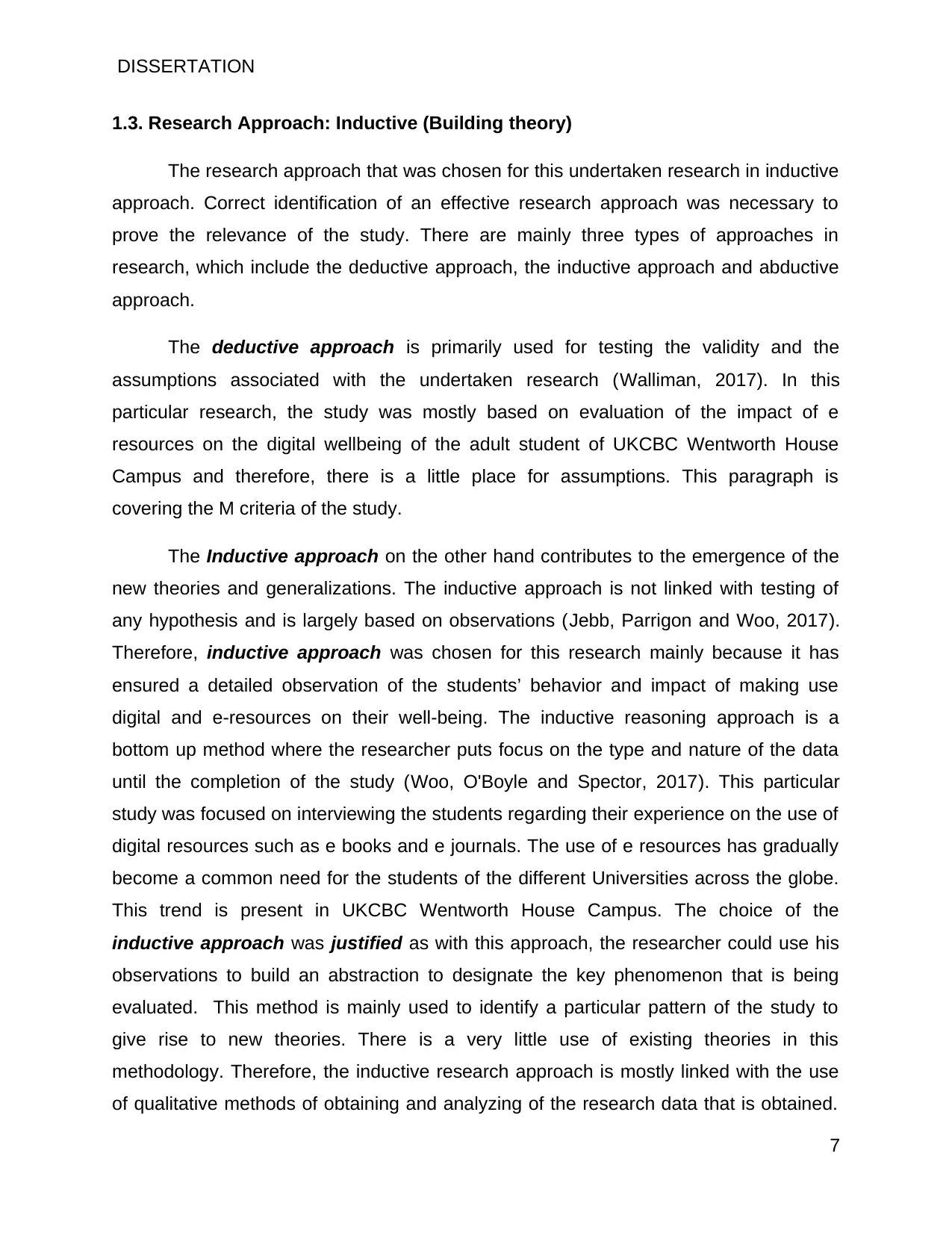
DISSERTATION
1.3. Research Approach: Inductive (Building theory)
The research approach that was chosen for this undertaken research in inductive
approach. Correct identification of an effective research approach was necessary to
prove the relevance of the study. There are mainly three types of approaches in
research, which include the deductive approach, the inductive approach and abductive
approach.
The deductive approach is primarily used for testing the validity and the
assumptions associated with the undertaken research (Walliman, 2017). In this
particular research, the study was mostly based on evaluation of the impact of e
resources on the digital wellbeing of the adult student of UKCBC Wentworth House
Campus and therefore, there is a little place for assumptions. This paragraph is
covering the M criteria of the study.
The Inductive approach on the other hand contributes to the emergence of the
new theories and generalizations. The inductive approach is not linked with testing of
any hypothesis and is largely based on observations (Jebb, Parrigon and Woo, 2017).
Therefore, inductive approach was chosen for this research mainly because it has
ensured a detailed observation of the students’ behavior and impact of making use
digital and e-resources on their well-being. The inductive reasoning approach is a
bottom up method where the researcher puts focus on the type and nature of the data
until the completion of the study (Woo, O'Boyle and Spector, 2017). This particular
study was focused on interviewing the students regarding their experience on the use of
digital resources such as e books and e journals. The use of e resources has gradually
become a common need for the students of the different Universities across the globe.
This trend is present in UKCBC Wentworth House Campus. The choice of the
inductive approach was justified as with this approach, the researcher could use his
observations to build an abstraction to designate the key phenomenon that is being
evaluated. This method is mainly used to identify a particular pattern of the study to
give rise to new theories. There is a very little use of existing theories in this
methodology. Therefore, the inductive research approach is mostly linked with the use
of qualitative methods of obtaining and analyzing of the research data that is obtained.
7
1.3. Research Approach: Inductive (Building theory)
The research approach that was chosen for this undertaken research in inductive
approach. Correct identification of an effective research approach was necessary to
prove the relevance of the study. There are mainly three types of approaches in
research, which include the deductive approach, the inductive approach and abductive
approach.
The deductive approach is primarily used for testing the validity and the
assumptions associated with the undertaken research (Walliman, 2017). In this
particular research, the study was mostly based on evaluation of the impact of e
resources on the digital wellbeing of the adult student of UKCBC Wentworth House
Campus and therefore, there is a little place for assumptions. This paragraph is
covering the M criteria of the study.
The Inductive approach on the other hand contributes to the emergence of the
new theories and generalizations. The inductive approach is not linked with testing of
any hypothesis and is largely based on observations (Jebb, Parrigon and Woo, 2017).
Therefore, inductive approach was chosen for this research mainly because it has
ensured a detailed observation of the students’ behavior and impact of making use
digital and e-resources on their well-being. The inductive reasoning approach is a
bottom up method where the researcher puts focus on the type and nature of the data
until the completion of the study (Woo, O'Boyle and Spector, 2017). This particular
study was focused on interviewing the students regarding their experience on the use of
digital resources such as e books and e journals. The use of e resources has gradually
become a common need for the students of the different Universities across the globe.
This trend is present in UKCBC Wentworth House Campus. The choice of the
inductive approach was justified as with this approach, the researcher could use his
observations to build an abstraction to designate the key phenomenon that is being
evaluated. This method is mainly used to identify a particular pattern of the study to
give rise to new theories. There is a very little use of existing theories in this
methodology. Therefore, the inductive research approach is mostly linked with the use
of qualitative methods of obtaining and analyzing of the research data that is obtained.
7
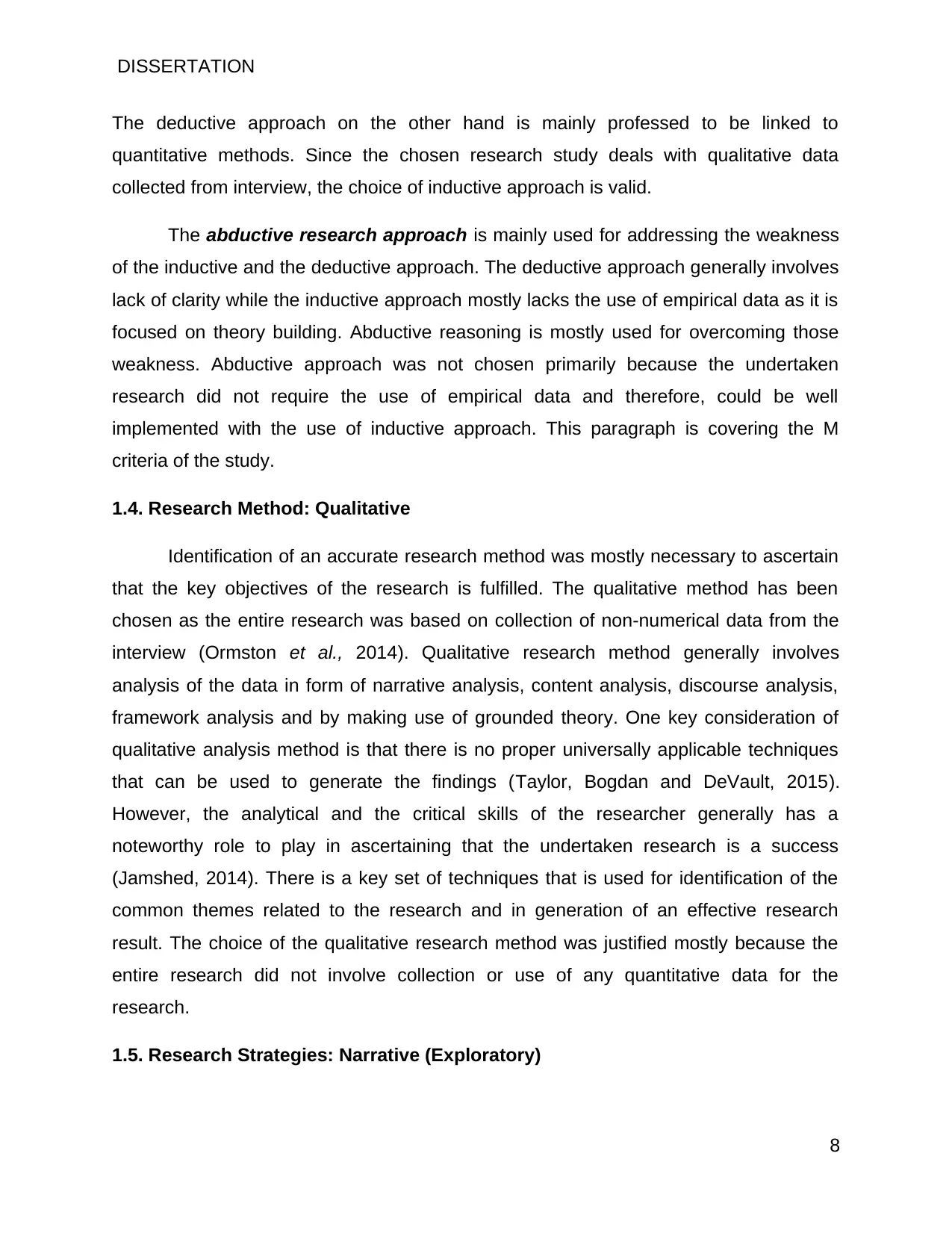
DISSERTATION
The deductive approach on the other hand is mainly professed to be linked to
quantitative methods. Since the chosen research study deals with qualitative data
collected from interview, the choice of inductive approach is valid.
The abductive research approach is mainly used for addressing the weakness
of the inductive and the deductive approach. The deductive approach generally involves
lack of clarity while the inductive approach mostly lacks the use of empirical data as it is
focused on theory building. Abductive reasoning is mostly used for overcoming those
weakness. Abductive approach was not chosen primarily because the undertaken
research did not require the use of empirical data and therefore, could be well
implemented with the use of inductive approach. This paragraph is covering the M
criteria of the study.
1.4. Research Method: Qualitative
Identification of an accurate research method was mostly necessary to ascertain
that the key objectives of the research is fulfilled. The qualitative method has been
chosen as the entire research was based on collection of non-numerical data from the
interview (Ormston et al., 2014). Qualitative research method generally involves
analysis of the data in form of narrative analysis, content analysis, discourse analysis,
framework analysis and by making use of grounded theory. One key consideration of
qualitative analysis method is that there is no proper universally applicable techniques
that can be used to generate the findings (Taylor, Bogdan and DeVault, 2015).
However, the analytical and the critical skills of the researcher generally has a
noteworthy role to play in ascertaining that the undertaken research is a success
(Jamshed, 2014). There is a key set of techniques that is used for identification of the
common themes related to the research and in generation of an effective research
result. The choice of the qualitative research method was justified mostly because the
entire research did not involve collection or use of any quantitative data for the
research.
1.5. Research Strategies: Narrative (Exploratory)
8
The deductive approach on the other hand is mainly professed to be linked to
quantitative methods. Since the chosen research study deals with qualitative data
collected from interview, the choice of inductive approach is valid.
The abductive research approach is mainly used for addressing the weakness
of the inductive and the deductive approach. The deductive approach generally involves
lack of clarity while the inductive approach mostly lacks the use of empirical data as it is
focused on theory building. Abductive reasoning is mostly used for overcoming those
weakness. Abductive approach was not chosen primarily because the undertaken
research did not require the use of empirical data and therefore, could be well
implemented with the use of inductive approach. This paragraph is covering the M
criteria of the study.
1.4. Research Method: Qualitative
Identification of an accurate research method was mostly necessary to ascertain
that the key objectives of the research is fulfilled. The qualitative method has been
chosen as the entire research was based on collection of non-numerical data from the
interview (Ormston et al., 2014). Qualitative research method generally involves
analysis of the data in form of narrative analysis, content analysis, discourse analysis,
framework analysis and by making use of grounded theory. One key consideration of
qualitative analysis method is that there is no proper universally applicable techniques
that can be used to generate the findings (Taylor, Bogdan and DeVault, 2015).
However, the analytical and the critical skills of the researcher generally has a
noteworthy role to play in ascertaining that the undertaken research is a success
(Jamshed, 2014). There is a key set of techniques that is used for identification of the
common themes related to the research and in generation of an effective research
result. The choice of the qualitative research method was justified mostly because the
entire research did not involve collection or use of any quantitative data for the
research.
1.5. Research Strategies: Narrative (Exploratory)
8
⊘ This is a preview!⊘
Do you want full access?
Subscribe today to unlock all pages.

Trusted by 1+ million students worldwide

DISSERTATION
Identification of an effective research strategy was necessary to ascertain that
any undertaken research is conducted in a planned manner and the related objective of
the study is fulfilled. The strategy or the design of the research chosen by the
researcher wad\s exploratory or the narrative approach (Tracy, 2019). Exploratory
strategy was chosen for the research as this particular strategy is mostly used to
address a problem that has not been clearly defined. Benefits of making use of e
resources has been already established through various researches, however, the
effect of making use of digital resources on adult students’ wellbeing was not clearly
defined (Silverman, 2016). This strategy was chosen as it is mostly intended in
establishment of the priorities in identification of the key issues linked with the use of
digital resources that can affect the digital wellbeing of the adult students. This
paragraph is covering the D criteria of the study.
The choice of exploratory study was justified as it has helped in understanding
the subject of the study in a preliminary manner and the researches that include the use
of direct observations in identification of the research problems. The use of exploratory
research further helped in defining the nature of problem for developing an accurate
understanding of the research problem.
Apart from exploratory research strategy, explanatory strategy is also used in the
researches where the key research problem is not correctly defined. This particular
strategy mainly defines priorities which further generates operational definition of the
problem and provides a better model of the research. This strategy is mostly used for
explaining the aspect of the study in a more accurate manner. However, the undertaken
study involves a clear problem definition and therefore, the explanatory strategy was not
opted in this study.
1.6. Data Collection and Analysis Approach
1.6.1. Data Collection Approach
The qualitative research method that was chosen for research involves collection
of the data from the students of UKCBC Wentworth House Campus to collect data from
the firsthand knowledge source. The method that was opted for collection of primary
9
Identification of an effective research strategy was necessary to ascertain that
any undertaken research is conducted in a planned manner and the related objective of
the study is fulfilled. The strategy or the design of the research chosen by the
researcher wad\s exploratory or the narrative approach (Tracy, 2019). Exploratory
strategy was chosen for the research as this particular strategy is mostly used to
address a problem that has not been clearly defined. Benefits of making use of e
resources has been already established through various researches, however, the
effect of making use of digital resources on adult students’ wellbeing was not clearly
defined (Silverman, 2016). This strategy was chosen as it is mostly intended in
establishment of the priorities in identification of the key issues linked with the use of
digital resources that can affect the digital wellbeing of the adult students. This
paragraph is covering the D criteria of the study.
The choice of exploratory study was justified as it has helped in understanding
the subject of the study in a preliminary manner and the researches that include the use
of direct observations in identification of the research problems. The use of exploratory
research further helped in defining the nature of problem for developing an accurate
understanding of the research problem.
Apart from exploratory research strategy, explanatory strategy is also used in the
researches where the key research problem is not correctly defined. This particular
strategy mainly defines priorities which further generates operational definition of the
problem and provides a better model of the research. This strategy is mostly used for
explaining the aspect of the study in a more accurate manner. However, the undertaken
study involves a clear problem definition and therefore, the explanatory strategy was not
opted in this study.
1.6. Data Collection and Analysis Approach
1.6.1. Data Collection Approach
The qualitative research method that was chosen for research involves collection
of the data from the students of UKCBC Wentworth House Campus to collect data from
the firsthand knowledge source. The method that was opted for collection of primary
9
Paraphrase This Document
Need a fresh take? Get an instant paraphrase of this document with our AI Paraphraser

DISSERTATION
data is interview. Since the study is focused mainly on understanding impression of
making use of digital resources on the wellbeing of the students the data required for
the research was collected directly from the adult students.
The method that was chosen for collection of primary data from the students of
UKCBC Wentworth House Campus is direct interview. Interviews are generally
indicated as qualitative research technique which generally involves a small number of
respondents (Mayer, 2015). Through the method of interview, a particular idea is
explored in relation to a particular idea, program or a situation.
Interviews are generally conducted in three different forms which include,
structured, semi structured and unstructured. The structured interview is the easiest
form of conducting an interview as it generally consists of a series of preset or
predetermined question that the chosen interviewees need to answer (Alshenqeeti,
2014). Therefore, data collected through this interview process is mainly straightforward
where comparison of the different answers can be made. The unstructured interview
is entirely different from structured interview as it involves collection of data in an
informal manner. This is least reliable from a research perspective as in this process no
questions are prepared for the interview. This type of interview is not reliable as there is
a high level of biasness observed in this process.
The semi-structured interview however, contains the components of both
structure and unstructured interviews. In this method of primary data collection, the
interviewer mainly formulates a set of same questions that are to be answered by all the
respondents. However, at the time of interview, additional questions can also be asked
to clarify the answers provided by the respondents. The method chosen for this
research is semi-structured interview as the interview was conducted with the student
and there was a need of further clarity with the primary answers that were provided by
the students (Powney and Watts, 2018). The choice of this method is justified as it
helped in collection of appropriate research data needed for understanding the influence
of the use of digital resources on the adult students of UKCBC Wentworth House
Campus. The semi-structured interview process has proven to be beneficial mainly
because it had eliminated the risk of biased results that are generally obtained by
10
data is interview. Since the study is focused mainly on understanding impression of
making use of digital resources on the wellbeing of the students the data required for
the research was collected directly from the adult students.
The method that was chosen for collection of primary data from the students of
UKCBC Wentworth House Campus is direct interview. Interviews are generally
indicated as qualitative research technique which generally involves a small number of
respondents (Mayer, 2015). Through the method of interview, a particular idea is
explored in relation to a particular idea, program or a situation.
Interviews are generally conducted in three different forms which include,
structured, semi structured and unstructured. The structured interview is the easiest
form of conducting an interview as it generally consists of a series of preset or
predetermined question that the chosen interviewees need to answer (Alshenqeeti,
2014). Therefore, data collected through this interview process is mainly straightforward
where comparison of the different answers can be made. The unstructured interview
is entirely different from structured interview as it involves collection of data in an
informal manner. This is least reliable from a research perspective as in this process no
questions are prepared for the interview. This type of interview is not reliable as there is
a high level of biasness observed in this process.
The semi-structured interview however, contains the components of both
structure and unstructured interviews. In this method of primary data collection, the
interviewer mainly formulates a set of same questions that are to be answered by all the
respondents. However, at the time of interview, additional questions can also be asked
to clarify the answers provided by the respondents. The method chosen for this
research is semi-structured interview as the interview was conducted with the student
and there was a need of further clarity with the primary answers that were provided by
the students (Powney and Watts, 2018). The choice of this method is justified as it
helped in collection of appropriate research data needed for understanding the influence
of the use of digital resources on the adult students of UKCBC Wentworth House
Campus. The semi-structured interview process has proven to be beneficial mainly
because it had eliminated the risk of biased results that are generally obtained by
10
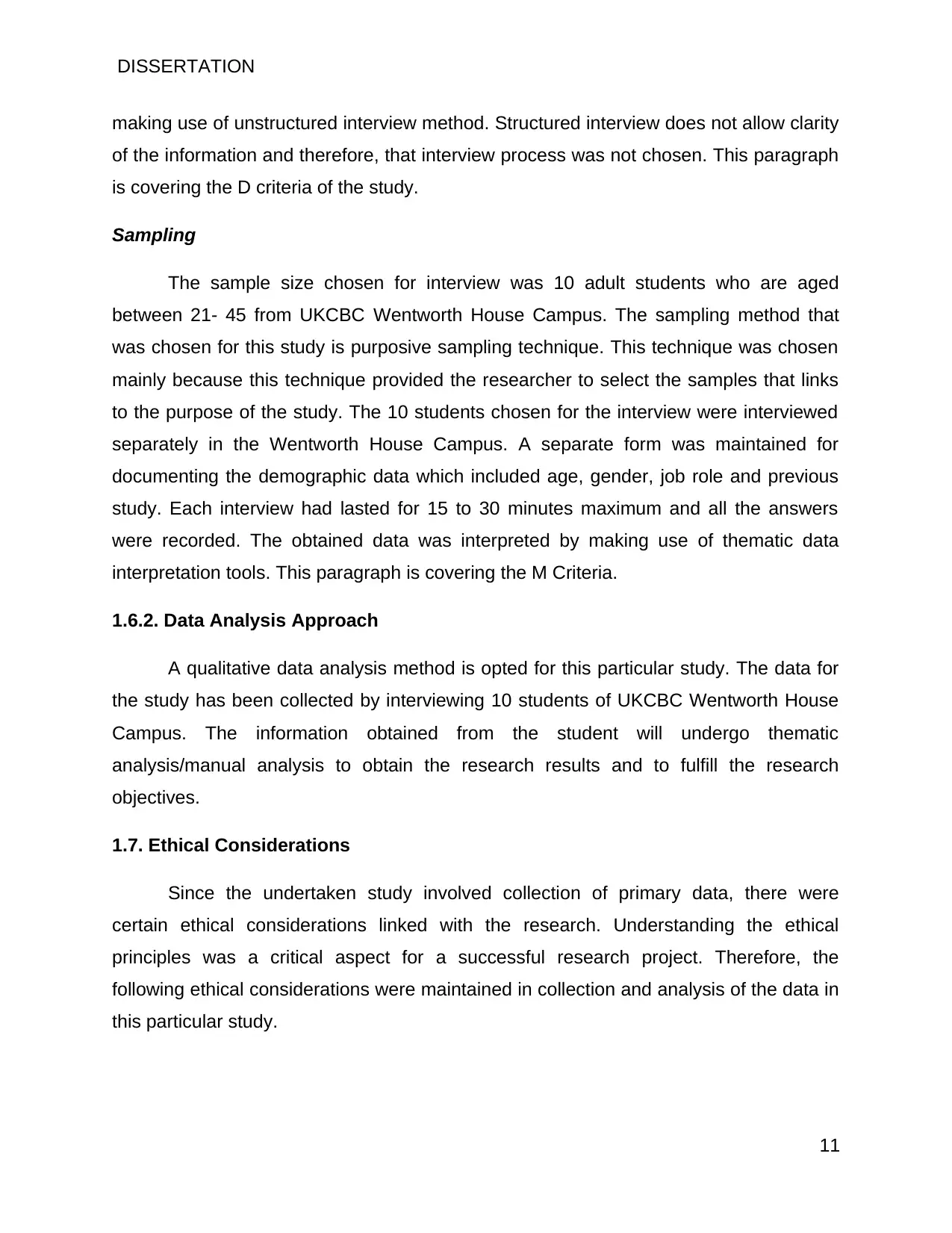
DISSERTATION
making use of unstructured interview method. Structured interview does not allow clarity
of the information and therefore, that interview process was not chosen. This paragraph
is covering the D criteria of the study.
Sampling
The sample size chosen for interview was 10 adult students who are aged
between 21- 45 from UKCBC Wentworth House Campus. The sampling method that
was chosen for this study is purposive sampling technique. This technique was chosen
mainly because this technique provided the researcher to select the samples that links
to the purpose of the study. The 10 students chosen for the interview were interviewed
separately in the Wentworth House Campus. A separate form was maintained for
documenting the demographic data which included age, gender, job role and previous
study. Each interview had lasted for 15 to 30 minutes maximum and all the answers
were recorded. The obtained data was interpreted by making use of thematic data
interpretation tools. This paragraph is covering the M Criteria.
1.6.2. Data Analysis Approach
A qualitative data analysis method is opted for this particular study. The data for
the study has been collected by interviewing 10 students of UKCBC Wentworth House
Campus. The information obtained from the student will undergo thematic
analysis/manual analysis to obtain the research results and to fulfill the research
objectives.
1.7. Ethical Considerations
Since the undertaken study involved collection of primary data, there were
certain ethical considerations linked with the research. Understanding the ethical
principles was a critical aspect for a successful research project. Therefore, the
following ethical considerations were maintained in collection and analysis of the data in
this particular study.
11
making use of unstructured interview method. Structured interview does not allow clarity
of the information and therefore, that interview process was not chosen. This paragraph
is covering the D criteria of the study.
Sampling
The sample size chosen for interview was 10 adult students who are aged
between 21- 45 from UKCBC Wentworth House Campus. The sampling method that
was chosen for this study is purposive sampling technique. This technique was chosen
mainly because this technique provided the researcher to select the samples that links
to the purpose of the study. The 10 students chosen for the interview were interviewed
separately in the Wentworth House Campus. A separate form was maintained for
documenting the demographic data which included age, gender, job role and previous
study. Each interview had lasted for 15 to 30 minutes maximum and all the answers
were recorded. The obtained data was interpreted by making use of thematic data
interpretation tools. This paragraph is covering the M Criteria.
1.6.2. Data Analysis Approach
A qualitative data analysis method is opted for this particular study. The data for
the study has been collected by interviewing 10 students of UKCBC Wentworth House
Campus. The information obtained from the student will undergo thematic
analysis/manual analysis to obtain the research results and to fulfill the research
objectives.
1.7. Ethical Considerations
Since the undertaken study involved collection of primary data, there were
certain ethical considerations linked with the research. Understanding the ethical
principles was a critical aspect for a successful research project. Therefore, the
following ethical considerations were maintained in collection and analysis of the data in
this particular study.
11
⊘ This is a preview!⊘
Do you want full access?
Subscribe today to unlock all pages.

Trusted by 1+ million students worldwide
1 out of 44
Related Documents
Your All-in-One AI-Powered Toolkit for Academic Success.
+13062052269
info@desklib.com
Available 24*7 on WhatsApp / Email
![[object Object]](/_next/static/media/star-bottom.7253800d.svg)
Unlock your academic potential
Copyright © 2020–2025 A2Z Services. All Rights Reserved. Developed and managed by ZUCOL.





